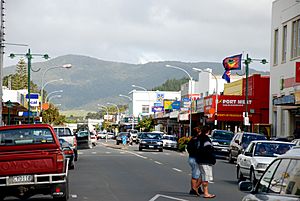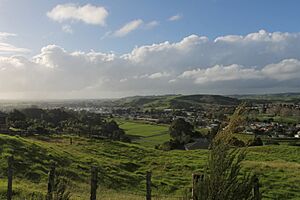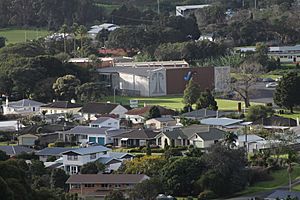Kaitaia facts for kids
Quick facts for kids
Kaitaia
|
|
|---|---|
 |
|
| Country | New Zealand |
| Island | North Island |
| Region | Northland |
| Territorial authority | Far North District |
| Ward | Te Hiku (General) / Ngā Tai o Tokerau (Māori) |
| Community | Te Hiku |
| Subdivision | Kaitāia |
| Electorates |
|
| Area | |
| • Total | 8.48 km2 (3.27 sq mi) |
| Population
(June 2023)
|
|
| • Total | 6,390 |
| • Density | 753.5/km2 (1,951.7/sq mi) |
| Time zone | UTC+12 (NZST) |
| • Summer (DST) | UTC+13 (NZDT) |
| Postcode(s) |
0410
|
| Area code(s) | 09 |
Kaitaia (Māori: Kaitāia) is a town in the Far North District of New Zealand. It sits at the bottom of the Aupōuri Peninsula, about 160 kilometers northwest of Whangārei. It is the last big town on State Highway 1. Ahipara Bay, which is the southern end of Te Oneroa-a-Tōhē / Ninety Mile Beach, is only 5 kilometers to the west.
The main jobs in Kaitaia are in forestry (working with trees) and tourism (helping visitors). The town's name Kaitāia means 'ample food' in the Māori language, where kai means food.
The Muriwhenua are a group of six northern Māori iwi (tribes). They live in the northernmost part of the North Island around Kaitaia.
Contents
Exploring Kaitaia's Past and Culture
How European Settlers Arrived
The Kaitaia Mission Station was set up between 1833 and 1834. This happened after people from the Church Missionary Society (CMS) visited the area. Key figures included Joseph Matthews and William Gilbert Puckey. Puckey and Matthews married two sisters, Matilda and Mary Ann Davis. These families lived closely together, first in simple huts and then in houses they built.
Puckey and the Davis sisters knew the Māori language very well. They spoke Māori often to help Joseph Matthews learn it. Their families grew and married into each other, forming the first European settler community. At one point, the CMS wanted one of them to move to a new area. However, Nōpera Panakareao, a local Māori leader, wrote a letter asking them to stay.
In February 1841, about 500 Māori people attended a CMS church service. By 1852, disagreements between a chief and his tribe were handled differently. The influence of the missionaries meant that old ways of solving problems were changing.
Richard Matthews, Joseph's brother, also joined them for a time. He had been a missionary on HMS Beagle with Charles Darwin. Richard helped at Kaitaia as a catechist, teaching Christian beliefs.
Kaitaia's Railway History
There were plans in the 1920s to extend the Okaihau Branch railway to Kaitaia. Construction began, but in 1936, it was decided the line would not be useful. So, building stopped. The railway line ended in Okaihau until it closed in 1987. A old steam train, D 221, has been on display in Centennial Park since 1967.
Understanding Marae in Kaitaia
There are five marae (traditional Māori meeting places) near Kaitaia. A marae is a special place for Māori people to gather, celebrate, mourn, and discuss important matters. Each marae is connected to specific iwi (tribes) and hapū (sub-tribes).
- Te Uri o Hina Marae in Pukepoto is linked to Te Rarawa iwi.
- Te Rarawa Marae, also in Pukepoto, is connected to Te Rarawa iwi.
- Te Paatu Marae in Pamapuria is linked to Ngāti Kahu iwi.
- Ōturu Marae in Ōturu is connected to Ngāti Kahu iwi.
- Mahimaru Marae in Awanui is linked to Ngāi Takoto iwi.
Recent Events in Kaitaia
In October 2020, a building that used to be the Kaitaia Bowling Club caught fire. The fire started because of an electrical problem in the kitchen. A few months later, in March 2021, the same building caught fire again. The police thought this second fire might have been started on purpose. The building was later taken down.
Kaitaia's Population and People
Kaitaia is a small urban area. It covers about 8.48 square kilometers. As of 2023, about 5,955 people live there. The population has grown by about 1.5% since 2018.
Most people in Kaitaia identify as Māori (about 70.4%) or European (about 48.2%). Some people also identify as Pasifika or Asian. English is spoken by most people (95.6%), and the Māori language is spoken by 22.1%.
Many people in Kaitaia identify as Christian (38.3%) or have Māori religious beliefs (10.6%). A large number of people (41.2%) say they have no religion.
The median age in Kaitaia is 33.0 years old. This is younger than the national average for New Zealand. About 25.3% of the population is under 15 years old.
Understanding Kaitaia's Weather
Kaitaia has a mild climate. It is known as a humid subtropical climate or an oceanic climate. This means it has warm, humid summers and mild winters. It generally gets rain throughout the year.
| Climate data for Kaitaia | |||||||||||||
|---|---|---|---|---|---|---|---|---|---|---|---|---|---|
| Month | Jan | Feb | Mar | Apr | May | Jun | Jul | Aug | Sep | Oct | Nov | Dec | Year |
| Mean daily maximum °C (°F) | 23.9 (75.0) |
24.6 (76.3) |
23.0 (73.4) |
20.9 (69.6) |
18.5 (65.3) |
16.4 (61.5) |
15.6 (60.1) |
15.8 (60.4) |
17.0 (62.6) |
18.1 (64.6) |
19.7 (67.5) |
21.9 (71.4) |
19.6 (67.3) |
| Daily mean °C (°F) | 19.5 (67.1) |
20.0 (68.0) |
18.6 (65.5) |
17.0 (62.6) |
14.8 (58.6) |
12.8 (55.0) |
12.1 (53.8) |
12.2 (54.0) |
13.4 (56.1) |
14.5 (58.1) |
15.8 (60.4) |
17.9 (64.2) |
15.7 (60.3) |
| Mean daily minimum °C (°F) | 15.1 (59.2) |
15.5 (59.9) |
14.2 (57.6) |
13.0 (55.4) |
11.1 (52.0) |
9.2 (48.6) |
8.5 (47.3) |
8.6 (47.5) |
9.7 (49.5) |
10.8 (51.4) |
11.9 (53.4) |
13.8 (56.8) |
11.8 (53.2) |
| Average precipitation mm (inches) | 82.0 (3.23) |
92.5 (3.64) |
82.0 (3.23) |
97.7 (3.85) |
131.9 (5.19) |
149.1 (5.87) |
165.4 (6.51) |
140.0 (5.51) |
126.7 (4.99) |
97.8 (3.85) |
86.2 (3.39) |
99.6 (3.92) |
1,350.8 (53.18) |
| Source: NIWA Climate Data | |||||||||||||
Getting Around Kaitaia
You can travel to and from Kaitaia by bus. InterCity runs a daily bus service connecting Kaitaia to Auckland, passing through Kerikeri. There's also a local service called Busabout that goes to nearby places like Ahipara, Mangonui, and Pukenui.
Kaitaia Airport is the only airport in the upper Far North District. It offers flights to Auckland. Air New Zealand used to fly there, but now Barrier Air provides the services.
Kaitaia's Economy and Industries
Tourism: Where Journeys Begin
Kaitaia is an important town for visitors in the Far North of New Zealand. It's close to popular spots like Ahipara and is on State Highway 1, which leads up to Cape Reinga. The town's motto is "Where journeys begin," because it's often the starting point for trips further north.
Every March, there's a fun Snapper Surf Casting Competition held on Te Oneroa-a-Tōhē (Ninety Mile Beach).
Forestry: Trees and Timber
The Aupouri Forest, located north of Kaitaia, provides pine logs. These logs are then processed at the Juken Nissho Mill in Kaitaia, turning them into timber.
There's also an industry that extracts ancient swamp Kauri (Agathis australis) trees. These are very old trees found buried in swamps.
Farming and Food Production
Kaitaia is in the Awanui River area. This region is good for farming, especially dairy farms and farms raising sheep and beef. Further north of Kaitaia, the avocado industry is growing, with many orchards in the area.
Wine production is also increasing in Kaitaia. One of the biggest vineyards is the Karikari Estate. Mānuka honey is another growing industry here.
Learning in Kaitaia: Schools and Education
Kaitaia has several schools for different age groups.
- Kaitaia Primary School, which opened in 1875, is for younger students.
- Kaitaia Intermediate is for middle school students and separated from Kaitaia Primary in 1968.
- Kaitāia College is the main high school. It started as part of Kaitaia School and became its own school in 1951.
There are also other schools:
- Te Kura Kaupapa Māori o Pukemiro is a Kura Kaupapa Māori school. This means it teaches completely in the Māori language.
- Pompallier School is a Catholic primary school.
- Oturu School is another primary school located northeast of Kaitaia.
All these schools are co-educational, meaning both boys and girls attend.
NorthTec polytechnic also has a campus in Kaitaia. This offers further education and training for adults.
Famous People from Kaitaia
Many notable people have lived in or are connected to Kaitaia:
- Nopera Pana-kareao (?–1856) – a tribal leader and evangelist.
- Margaret MacPherson (1895–1974) – a journalist.
- Sophia Taylor (1847–1930) – a hostess, suffragist, and landowner.
- Mike Burgoyne (rugby union) – an All Black rugby player, born in Kaitaia.
- Peter Jones (New Zealand rugby union) – an All Black rugby player, born in Kaitaia.
- Victor Yates (rugby) – an All Black rugby player, born in Kaitaia.
- Shelley Kitchen – a squash player who won medals at the Commonwealth and World Championships, born in Kaitaia.
- Lance O'Sullivan (doctor) – a doctor who worked in Kaitaia from 2012 to 2018.
- Ricky Houghton – an entrepreneur who worked in Kaitaia from 2001 to 2022.



